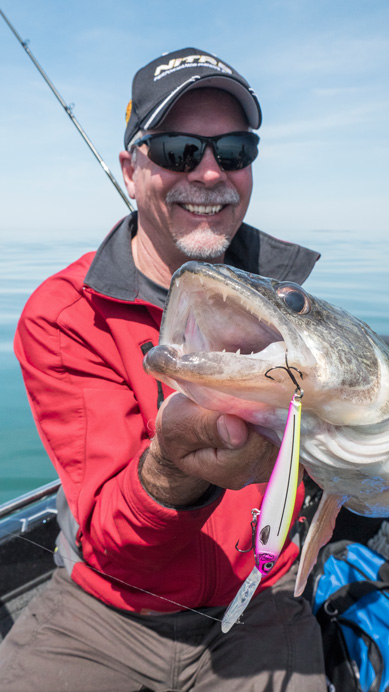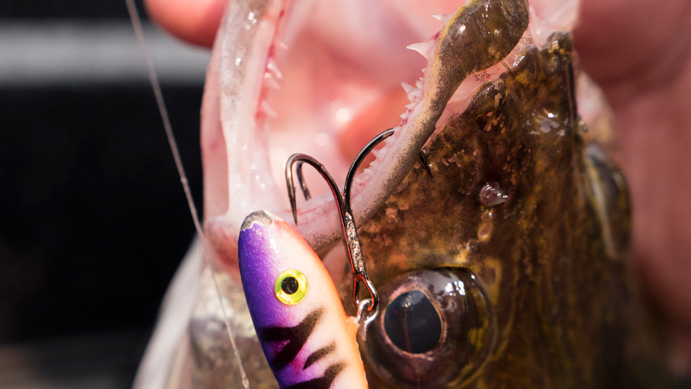Rev Up Lazy Walleyes
by Gary Parsons and Keith Kavajecz
We like going out to eat at buffets. There are endless choices to put on our plate and we can fill our stomachs to the point of having to loosen up the belt a notch without having to put any work into making the meal!
Walleye also like to take advantage of an effortless meal. Right now the lakes are a buffet, full of natural bait like bugs, larvae, and minnows. With such easy pickings, the fish get lazy and often need to be provoked to strike the bait.
So to rev the fish up and get a reactionary bite, we often have to resort to more aggressive tactics. Speed, sound and flash will often be triggers to get an already full walleye to take one more bite. Listed below are variations on some common (and some uncommon) techniques to fire them up.
Jigs With Action Tails
 Jigging is often thought of as a finesse technique. But add in an artificial “action” tail and it can trigger bites. While many anglers think shallow when jigging, during the summer this fishing is often done over deep-water structure with 3/8oz-1/2oz jigs. We like to tip the jig with a 3” or 3.5” Berkley Ripple Shad. The ripples on the body of this bait give it a lot of flexibility and a very attractive action. For this bait to be most effective, it is important to be sure that the body is on the jig straight. You can achieve this by sticking the hook through the nose of the shad and having it exit through the back on the seam that is left from production.
Jigging is often thought of as a finesse technique. But add in an artificial “action” tail and it can trigger bites. While many anglers think shallow when jigging, during the summer this fishing is often done over deep-water structure with 3/8oz-1/2oz jigs. We like to tip the jig with a 3” or 3.5” Berkley Ripple Shad. The ripples on the body of this bait give it a lot of flexibility and a very attractive action. For this bait to be most effective, it is important to be sure that the body is on the jig straight. You can achieve this by sticking the hook through the nose of the shad and having it exit through the back on the seam that is left from production.
Another great option is the larger profile 3.5” Berkley Pro Shad. It works differently than the Ripple Shad in that the body stays almost stationary but the paddle tail moves with the slightest jigging action.
In both cases, sweep the jig and tail off the bottom 1-2 feet, then hold the rod still and let the bait swim back to the bottom. Often by using no stretch line like Fireline or NanoFil you will feel the vibration (buzz) of the paddle tail. That vibration is what will fire up walleyes.
Blade Baits
This is also a good time of year to use blade baits – we like the Johnson Thin Fishers. They are easy to fish correctly because their vibration is so easy to feel. Use no stretch 10lb Berkley NanoFil and a two-foot Berkley100% Fluorocarbon leader. You will want to use a medium to medium-heavy 6-7ft long rod, with a lot of backbone such as the Bass Pro Shops Walleye Angler WL70MS for this type of fishing.
There are two ways to fish them. The first way is to fish them vertically. Drop the lure to the bottom and aggressively lift it up six to twelve inches. On each stroke you will be able to feel the vibration of the lure. Let the fish tell you how much and how aggressively to lift the bait. The combination of flash and vibration make blade baits hard for walleyes to resist.
The second way is pitching them out and working them back to the boat with a lift and drop. On the lift – similar to jigging – feel for the vibration. Once you get them back to the boat, vertical jig them. Many times the fish will follow them to the boat and then strike when you change to a vertical jigging action.
Shiver Minnows
One technique that has become very popular in the past couple years is “Shivering” with Moonshine Shiver Minnows. We “shivered” our way to first and second place at the NWT tournament on Bays de Noc in 2014. Up until that time, these minnow shaped baits were primarily used for ice fishing.
 The best way to use a Shiver Minnow is to entice the walleye with a “walk-the-dog” type motion, followed by a glide. To accomplish this, work the bait close to the bottom, but try to avoid hitting the bottom a lot. Cast it out and let it hit bottom. Follow this by sweeping the rod up three feet, almost to the point of snapping it up. This makes the lure dart out to the side. Then immediately drop the rod tip to give it slack and let the bait turn around and glide to center as you reel up the slack line. Just before your lure hits the bottom again, repeat the cadence 2 to 5 times. On the last rip, hold the rod tip up letting the bait glide to the bottom. Almost all of the bites will come on the glide, so be ready to set the hook if you feel a bite or if you feel weight when you go to start the cadence again.
The best way to use a Shiver Minnow is to entice the walleye with a “walk-the-dog” type motion, followed by a glide. To accomplish this, work the bait close to the bottom, but try to avoid hitting the bottom a lot. Cast it out and let it hit bottom. Follow this by sweeping the rod up three feet, almost to the point of snapping it up. This makes the lure dart out to the side. Then immediately drop the rod tip to give it slack and let the bait turn around and glide to center as you reel up the slack line. Just before your lure hits the bottom again, repeat the cadence 2 to 5 times. On the last rip, hold the rod tip up letting the bait glide to the bottom. Almost all of the bites will come on the glide, so be ready to set the hook if you feel a bite or if you feel weight when you go to start the cadence again.
A #2 or #3 Shiver Minnow tends to work best for us. We alter the bait by replacing the small “ice fishing” treble hook on the belly of it with a Mustad UltraPoint KVD Elite Triple Grip Treble Hook (TG76BLN). Use a #4 hook for the #3 Shiver Minnow and a #6 on an “O” ring for the #2 Shiver Minnow. This bigger hook has an inward bend that helps keep the fish hooked, but a short shaft to prevent foul hooking.
Contour Cranking
With the walleyes often spread out on structure this time of year, contour cranking on big structure, such as shorelines and large reefs, is another option for triggering bites. On structure it is important to keep the baits near bottom. Don’t be afraid to let them occasionally “tick” or even “bang” the bottom too.
You will want to crank faster than normal, pulling the lures at 2.2mph -2.5mph. High action cranking usually means using a bigger bait, such as a #7 or #9 Berkley Flicker Shad. Another good choice is the #9 or #11 Berkley Flicker Minnow, which has an action with a bit of a “kick”. The exception would be a #5 Flicker Minnow. Even though its small in size, the #5 does great at higher speeds and is flat out a fish catching machine.
Remember, walleyes are just like us! They like the “easy” meal when it is available, but if they see something they can’t resist, they will go after it even if they are full! If you present a subtle approach when they are at the buffet line, you won’t get bit. Instead, use a more aggressive style of fishing and make them take The Next Bite!










